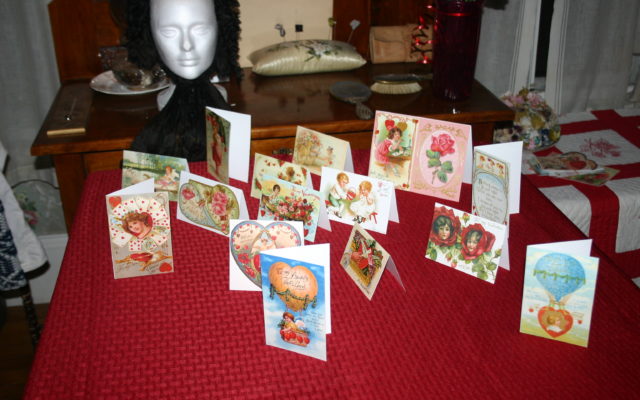
PRESQUE ISLE, Maine — Valentine’s Day guests at the Presque Isle Historical Society’s 1875 Vera Estey House Museum heard a local story of lost love and learned about Victorian dating customs during two evening tours.
Kim Smith, society secretary and treasurer, greeted guests in the Estey House kitchen in Victorian-era dress. She said Estey, an upper-middle-class woman, lived in the home both as a child and adult, never marrying or having children — which was considered unusual for Victorian women, who were expected to “court” to find a husband.
But young Estey did have a boyfriend, Smith said, who asked her father, John Estey, for her hand in marriage. John Estey was a widower and likely did not want his daughter to move to Boston, where her suitor worked as a dentist, so he told her she could not get married. At that time older parents often lived with their grown children, who cared for them as they aged.
“Vera’s father told her that if she didn’t get married, he would buy her the largest diamond ring he could find,” Smith said. “Vera chose the ring instead.”
Smith explained “floriography,” the language of flowers, explaining that certain colors or floral arrangements had meanings related to love and relationships. Red roses symbolized love, yellow roses joy or jealousy and white roses innocence or purity.
The arrangement of four certain flowers had a completely different meaning.
“When you put these flowers together, a michaelmas daisy meant ‘farewell,’ a striped carnation meant ‘I cannot be with you,’ a columbine meant ‘desertion’ and a cherry blossom meant ‘impermanence,’” Smith said.
She explained some of the strict rules for courting couples, who were not allowed to be alone together or hold hands unless they were engaged, and wealth and social status were considered more important than romantic love. They could not be alone outside after dark and had to have a chaperone with them at all times.
During Estey’s lifetime, Victorian women completed their “education” at 17, which included learning to sing, play piano, sew and cook. A formal coming-out party symbolized they were ready for marriage. Engagement was followed by a series of “negotiations.”
“The man would have wanted some type of dowry in exchange for marrying the woman, and if her parents were wealthy he would have likely received land or money as a result,” Smith said. “Marriage was pretty much a business arrangement.”
Guests could choose a replica of a Victorian valentine, and ladies received red carnations. The group enjoyed champagne or sparkling cider, served by historical society volunteers Marilyn and Richard Nadeau.
Presque Isle resident Carli Cleaves attended the tour with her husband, Alan Cleaves, and said she enjoyed learning about how the Victorians’ customs differed from what is familiar today.
“I was surprised to learn how each flower had its own meaning and how everything about dating was different than today,” Carli Cleaves said. “I like how the tour gives people something unique to do on Valentine’s Day than just dinner and a movie.”
This was the historical society’s first Valentine’s Day event at the Estey home, and the group plans to make it an annual event.
“We had wanted to host a Valentine’s Day event for several years now, so we thought we could make this event unique by talking about Victorian courting customs,” Smith said. “We hope that as more people learn about this particular tour, we can use every room in the home and expand upon what we talked about this year.”
- Guests at the Vera Estey House Museum during the first annual Victorian Valentine tours, hosted by the Presque Isle Historical Society on Wednesday, Feb. 14, got to chose a replica Victorian valentine. (Melissa Lizotte)








